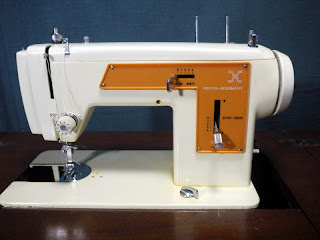Frister Rossmann Manual Cub 420

Hi - if I understand your questions you're trying to wind a bobbin on the top, and haven't got as far as sewing yet. To do this you usually have to put the bobbin on the top spool for it, and move that into position so that it turns. To disengage the needle so it doesn't go up and down whilst you wind the bobbin up, on most machines you have part of the main drive wheel (on the far right) which turns against the rest of it, disengaging the part of the drive which powers the needle going up and down. Or at least that's how it works on most machines.
Posted on May 09, 2013. • 152 Answers SOURCE: 1.
Frister+Rossmann Cub 4 Sewing Machine Instruction Manual Immediate Download PDF. Frister+Rossmann Cub 6 & 7 Sewing Machine Instruction Manual Immediate Download PDF. What Is Microsoft Help Library Agent more.
Make sure the needle is up in the machine all the way. Make sure the flat side of the needle is facing the rear of the machine 3. Only turn the handwheel on the side of the machine towards you, never away from you.
4. Download Game Ukuran 10 Mb In Kb. Double check your threading of the top of the machine. Also make sure your using the proper needle, your machine takes the most common needle on the market but some look like it and are shorter or longer and wont work properly. Also make sure your not buying needles for a singer serger.
Posted on Oct 07, 2009. • 192 Answers SOURCE: If you turn the handwheel, can you see a metal ring rotating around the outer edge of the bobbin case? If not rotating, broken gear or timing belt off. If that ring is turning, remove the needle plate and bobbin case.
As this ring now rotates, you will a finger on the ring that will pass behind the needle from right to left and it should catch the thread from the eye of the needle. If this finger, the 'hook' passes above the eye, you have a timing problem.
Posted on Feb 16, 2010. The heart of sewing is producing a well tensioned seam and achieving this with any sewing machine will be difficult if you don't wind a bobbin smoothly and with even tension onto the thread. If you look at your bobbin and the thread on it looks all lumpy and uneven, then this tip is for you. Each time you wind a bobbin, whatever sewing machine it is on, it is really important to keep even tension on the thread as it winds onto the bobbin. Many machines will have a little tension disc you take the thread around but your technique is important too. Usually you take the thread from your spool of cotton on the right, across to the left on the top of the machine and around a tension disc, or through a thread eye, then back to the right to your bobbin winding spindle, if your bobbin has holes in it, then pull the thread tail up through a hole and pop it onto the spindle.
Engage the spindle by pushing across against the stop. Now start winding SLOWLY while holding the thread tail up in the air until the core of the bobbin has been covered in fully and your thread has covered up the starting point to hold the beginning tail. Stop winding, and trim the tail off against the bobbin with a pair of snips. Now resume winding at 1/2 to 3/4 speed and do two things, one with each hand. With one hand put tension onto the top of the spool you are winding thread off - use the curve of your scissors handle into the indent on top. And with your other hand, give the thread a nudge as it winds onto the bobbin to ensure you wind fully across the whole bobbin evenly. Watch it carefully to ensure that you get a smooth even wind. X Plane Cirrus Jet Manual Cut.
An analagy: if you wind the garden hose onto the hose reel really fast and let it go anywhich way, the hose will kink and wind mostly in the middle then the reel's full and you've still got half the hose to put away. Thread is the same, its been wound onto a spool by a machine in a very precise way; you want the same smooth evenly tensioned winding onto your bobbin so that when you stitch out the seam the thread is consistently fed off the bobbin. Don't be tempted to wind flat out and just let it take its own path as you won't get good smooth bobbins of thread. And if you let the thread come off the spool at a fast pace the spool may bounce around, causing fluctuations in the tension on the thread. When you stich a seam, the thread will relax unevenly in your seam causing puckers and ho hum stitching.